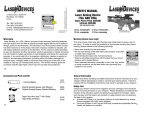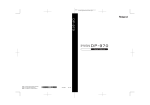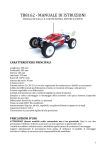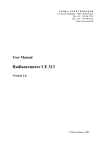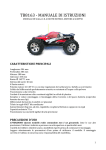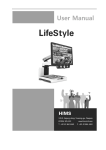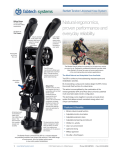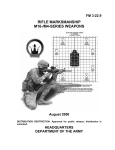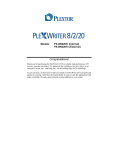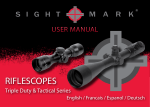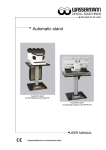Download Laser Devices Borelight MBS-1WE Manual
Transcript
MBS-1WE BORELIGHT USER'S MANUAL Manufactured by Laser Devices Inc. Nov 2001 2 Harris Court, Suite A-4 Monterey, CA 93940 U.S.A Tel: (831) 373-0701 Fax: (831) 373-0903 E-mail: [email protected] www.laserdevices.com Warning: Laser Light The MBS-1WE borelight when activated emits a laser light that has been determined to pose a risk of eye injury. In order to avoid the possibility of injury, please adhere to the following warnings: * Avoid looking directly into the laser beam. * Do not look directly at the laser light using scopes or binoculars. * Avoid shining the laser onto mirrored surfaces. * Do not direct the laser into the eyes or face of persons or animals. * Observe all safety precautions with the laser that you would observe with a loaded firearm. LASER LIGHT AVOID DIRECT EYE EXPOSURE OUTPUT 5mW WAVELENGTH 632 - 650nM CLASS IIIa LASER PRODUCT WARRANTY INFORMATION Laser Devices, Inc. (LDI) offers a one-year limited warranty from the date of original purchase against failure due to defect in design, parts and workmanship (normal wear and tear excluded). The warranty does not cover batteries and the plastic alignment inserts. The warranty is void if the product serial number has been removed or in the event the product has been misused, modified or neglected. LDI will replace defective products at its discretion. To the maximum extent permitted by law LDI disclaims all other warranties whether expressed or implied, including but not limited to implied warranties of merchantability and fitness for a particular purpose. In no event shall LDI or its suppliers, distributors, dealers or agents be liable for any damages whatsoever (including without limitation damages for personal injury, wrongful death or pecuniary loss) arising out of the use or the inability to use any LDI manufactured product. This limited warranty gives the purchaser specific legal rights, which may vary from state to state or jurisdiction to jurisdiction. 20 Rules for Safe Use of the MBS-1WE ALWAYS use the factory supplied inserts and insert retaining screw. ALWAYS when trueing the MBS-1WE in the bore of the weapon turn the device in a clockwise direction. ALWAYS when finished boresighting the weapon make sure that the insert and the retainer screw did not become detached in the barrel of the weapon. ALWAYS remove the borelight from the weapon as soon as you have finished aligning the sight. ALWAYS take your weapon to the range and test fire it to confirm proper sight alignment after using the borelight. ALWAYS assume that the sight alignment calculated using the borelight is only an approximation of the actual impact point where a bullet will strike the target. NEVER boresight a loaded gun. 1 Rules of Firearms Safety ALWAYS keep the gun pointed in a safe direction. ALWAYS keep your finger off the trigger until ready to shoot. ALWAYS keep the gun unloaded until ready to use. ALWAYS be sure the gun is safe to operate and the barrel is clear of any obstruction. ALWAYS use the proper factory made ammunition for your particular gun. ALWAYS know your target and what is beyond it. ALWAYS wear eye and ear protection when shooting. ALWAYS store guns and ammunition in separate locked containers so they are secure and not accessible to children or unauthorized persons. ALWAYS treat every gun as if it were loaded. NEVER use alcohol or drugs before or during handling a gun. NEVER bring a loaded firearm into a building. NEVER transport a loaded firearm. CHAPTER 4 TROUBLESHOOTING Section 4.1. Unit Fails to Operate 1. Fails to operate. a. Replace the battery (see instructions). b. Check the battery installation to make sure the batteries were installed with the positive (+) terminal facing out. 2. Laser light is weak or dim. a. Replace the battery (see instructions). b. Check the front cap and lens of the laser to make sure that it is not covered with dirt. If the front cap is dirty, clean gently with a cotton swab or soft clean cloth taking care not to scratch the lens. 3. If the borelight still fails to operate, please contact the manufacturer for assistance. See Service and Repair, Section 4.2 Section 4.2. Service and Repair The borelight produt is manufactured to provide years of rugged and dependable use. In the event the borelight ever needs to be repaired, please contact Laser Devices, Inc. directly for a return authorization number. Once you obtain the return authorization number, package the product securely and return it postage paid to LDI. In the event the product is not covered by the warranty, you will be notified as to the nature and the cost of the necessary repair. LASER DEVICES, INC. 2 Harris Court, Suite A-4 Monterey, CA 93940 U.S.A. Tel.: (831) 373-0701 Fax: (831) 373-0903 Internet: www.laserdevices.com 2 19 CHAPTER 1 INTRODUCTION USAGE 6. Mark the OFFSET DISTANCE below the center point marked on the target. 7. Adjust your weapon sight to the OFFSET POINT you have marked on the target. 8. Take your weapon to the range and test fire it to confirm the alignment of the sight. DANGER: Ballistics tables may be wrong! Errors may have crept into the published data. In addition, it should be kept in mind that ballistics performance is dependent on the characteristics of each barrel, air temperature, humidity, elevation, and a variety of other factors. In addition, a very small misalignment of the borelight may move the actual impact point several inches. As such, the offset point derived herein should always be considered an approximation. Hence, the trajectories provided herein and the information presented by any other source should be considered, at best, an approximation. Please read this instruction manual before you attempt to use the MBS-1WE borelight. While reading the manual pay special attention to items in bold text addressing WARNINGS and possible DANGERS associated with the improper use of the borelight product. PRODUCT DESCRIPTION The MBS-1WE is a precision laser instrument used to align optical scopes, open sights and laser aiming devices. This manual contains sections relating to the operation, maintenance and troubleshooting of the MBS-1WE borelight. 1-1 GENERAL INFORMATION A. Model Number and Equipment Name Laser Borelight, Model MBS-1WE B. Contact Information for the Manufacturer Laser Devices, Inc. 2 Harris Court, Suite A-4 Monterey, CA 93940 U.S.A. Tel: (831) 373-0701 Fax: (831) 373-0903 E-mail: [email protected] www.laserdevices.com 18 3 SECTION 1-2 GLOSSARY Aiming Point The exact point on the target that you wish to hit. Axis of the Barrel A straight line from the center of the weapon barrel to the target. Bore The inside of the weapon barrel. Bore Rod A part of the borelight that fits into the bore of the weapon. Danger Conditions or procedures that must be observed to avoid the risk of serious injury or death. Elevation Vertical (up/down) movement of a sight. Insert The plastic part used to configure the borelight for aligning different calibers of weapons. 5. Assuming that you will boresight a .308 Cal. rifle firing the bullet described above at 50 yards, the offset point to be marked on the boresight target is calculated as follows: a. add the True Bullet Drop of .49 inches; and b. the Expected Trajectory Height above the line of sight at 50 meters from the ballistics table for the range at which you want to align your weapon sight. This height according to the ballistics table is 1.56 inches. See Figure 3-7 & 3-8. Total Offset Distance 2.05" Sight to be zeroed for accuracy at 300 yards Target at 50 Yards Insert Retainer Screw The screw part used to attach the insert to the bore rod. Offset distance 2" Laser beam path from borelight Warning Conditions or procedures that must be observed to avoid damage to equipment or risk of injury to persons. Zero Point ON Horizontal (left/right) movement adjustment of a sight. D U Windage FIGURE 3-7 Close-up of target at 50 yards ls ½ inch Each Square Equa The point on the target where the bullet will hit if the sight has been properly adjusted. Line of sight through open sight Laser beam path from borelight 0.48" true bullet drop @ 50 yards Bullet path 1.5" est. trajectory height over line of sight @ 50 yards FIGURE 3-8 4 17 Section 3.2. Calculating the Offset Distance NOTE: Calculating the offset requires access to a complete ballistics table or, better yet, a ballistics calculator. In the alternative, you may want to check out the offset calculator available on the Internet at http://wilson.simplenet.com/shareware/ borescope/index.html. Remember, any offset point derived using a ballis-tics table or a ballistics calculator shall be considered an approximation of the actual aim point. 1. Measure or calculate the distance between the center of the bore and the center of the sight. For example, if you are using an iron sight, then this distance will be the distance from the center of the bore to the top of the front post. A common offset distance is 1.5 inches. See Figure 3-6. Sight Offset D U ON FIGURE 3-6 2. Calculate the distance between the boresight target and end of the weapon barrel. This distance is usually not less than 10 yards and may be as great as 50-100 yards, depending upon the scope to be aligned and the visibility of the laser point. SECTION 1-3 EQUIPMENT CHARACTERISTICS AND FEATURES A. Characteristics of the Laser Borelight The borelight operates by projecting a laser light from the bore of the weapon to a target located at a known distance from the barrel of the weapon (usually 10 to 50 yards). B. Features ! Battery powered using a standard 3 volt lithium 123A battery. ! Easy twist-on and twist-off activation. ! Can be used in cold weather to -10°C or 0°F. ! Withstands high temperatures to +50°C or 123°F. ! May be stored without batteries at temperatures between 40°C and 80°C. ! Can be used at high altitudes to 10,000 feet. ! Waterproof to 30 feet. ! Offers an estimated 7,500 alignment activations before mean failure (not including batteries and inserts). ! External windage/elevation adjustments for trueing the borelight before use. 3. Determine the distance to which you want to align your weapon sight. This distance, for example, may be 200 yards or 300 yards. 4. Use a ballistics table or a ballistics calculator for the cartridge being used and determine the "actual bullet drop" over the distance at which you want to align your weapon sight. For example, the ballistics table may indicate that a .308 Cal. Hollow Point, Boat Tail Match King (Sierra) bullet will drop 19.75" over 300 yards. See sample table below. Range (Yards) Velocity Drop Inches (true) Drop (Zero @ 100) Drop (Zero @ 200) Drop (Zero @ 300) Muzzle 3000 0.00 -1.5 -1.5 -1.5 50 2906 -.48 -0.24 0.49 +1.56 16 100 2815 -1.99 -0.00 1.44 +3.59 200 2637 -8.37 -2.89 0.0 +4.30 300 2466 -19.75 -10.78 -6.45 0.0 5 SECTION 1-4 LOCATION AND DESCRIPTION OF MAJOR COMPONENTS Top View Battery (123A) A. Windage Adjustment ON Battery 3V 123A - C. Laser Aperture (Avoid Eye Exposure) D U + B. Elevation Adjustment E. Housing MBS-1W/E Borelight D. Switch Assembly NOTE: Depending upon the distance from the end of the barrel to the target that is being used to align the weapon sight, the proper alignment point for the weapon sight (i.e. the offset point) may be above or below the imaginary straight line drawn through the sight to the target. See Figure 3-4. Borelight Rod Interface (Rifle) Target at 5 Yards Line of sight through sighting device Borelight Rod Interface (Pistol) G. Insert Retainer Screw Only Part # F2949 H. Insert .22 CAL/.223/5.56mm F2964 H. Insert .223 CAL/5.56mm OVERSIZE F3170 H. Insert .270 CAL/7mm F2965 H. Insert .30 CAL/.30-06/.308 CAL/7.62mm F2966 H. Insert .38 CAL/.357 CAL/9mm F2967 H. Insert .40 CAL/10mm F2969 H. Insert .44 CAL/.45 CAL F2970 H. Insert .50 CAL F2974 Metal Spring Insert .22/.223/5.56mm FA 03167 Laser beam path Bullet path FIGURE 3-4 4. The distance between the point on the target where the laser point projected by the borelight strikes the target and the point on the target to where scope or sighting device needs to be aligned so that a bullet fired from the weapon will strike the aim point at a given range is the "Offset Distance". See Figure 3-5. (OPTIONAL) Target at 5 Yards Offset distance Figure 1-2 BORELIGHT ZERO AND ALIGNMENT TARGET BORELIGHT ZERO AND ALIGNMENT TARGET D U ON FIGURE 3-5 Mark your offset on the target with a cross. Aim the at the cross and adjust your sight's windage and elevation until the bore light laser is centered on the circle in the center of the target. Mark your offset on the target with a cross. Aim the at the cross and adjust your sight's windage and elevation until the bore light laser is centered on the circle in the center of the target. I. Metric Alignment Target I. Inch Alignment Target 6 15 CHAPTER 3 CALCULATING OFFSET FOR SIGHT ALIGNMENT Section 3.1. General Principles 1. The borelight, when properly aligned in the weapon barrel, projects a laser point on the target that is in line with the axis of the barrel. In other words, the laser light travels in a straight line from the barrel of the weapon to the target. See Figure 3-1 below. SECTION 1-4 LOCATION AND DESCRIPTION OF MAJOR COMPONENTS A. Windage Adjustment. The windage adjustment knob is used to adjust the laser on a horizontal plane. Each click adjustment moves the beam one-half of the diameter of the laser point on the target. . B. Elevation Adjustment. The elevation adjustment knob is used to adjust the laser for elevation. Each click adjustment moves the beam one-half of the diameter of the laser point on the target. Target at 50 Yards C. Laser Aperture. The point where the laser light is emitted. Avoid direct eye exposure to the laser light projected from this aperture. Laser beam path from borelight D U ON FIGURE 3-1 2. A bullet when fired from a weapon held parallel with the ground immediately starts to drop as soon as it leaves the barrel. The actual rate of drop is determined in part by the velocity of the bullet. Thus, the path of the bullet will always be below the straight line of laser light projected from the borelight. See Figure 3-2. Target at 50 Yards Laser beam path from borelight D. Switch Assembly. The borelight is activated by tightening the Switch Assembly against the Housing. E. Housing. The body of the borelight that contains the battery, windage and elevation adjustments and the laser diode. F. Bore Rod. The stainless steel rod used in conjunction with the appropriate barrel insert to center the borelight in the barrel. The bore rod is supplied in two lengths -- long for aligning rifles and short for aligning pistols. Bullet drop distance Bullet path FIGURE 3-2 3. The optical scope or weapon sight is used to cant the barrel in an upward direction so that a bullet fired from the gun will trace an arc to the target. An imaginary straight line drawn through a properly aligned weapon sight attached to a weapon will trace a descending line that crosses the straight line from the bore of the weapon to the target. See Figure 3-3. G. Insert Retainer Screw. This is the metal screw assembly that is used to attach an insert to the bore rod. DANGER: Never use the borelight without the Insert Retainer Screw. H. Inserts. The plastic parts affixed to the bore rod with the Insert Retainer Screw. Each insert is sized to fit a specific caliber of barrel. I. Alignment Targets. Paper targets with metric or U.S. units used for aligning the sight and adjusting the borelight. Target at 50 Yards Line of sight through open sight Laser beam path from borelight FIGURE 3-3 14 Bullet path 7 1-5 PRODUCT SPECIFICATIONS A. Mechanical Specifications Weight with 123A battery & bore rod) Length (with bore rod) Width Height Housing Material Bore Rod Material Insert Material Windage & Elevation Increments 4.7 oz. (146 grams) 10.43 inches (26.49cm) 1.12 inches (2.84cm) 1.12 inches (2.84cm) Aircraft aluminum 6061T-6 Tempered stainless spring steel 420 Specially engineered plastic Repeatable in .4 milliradian increments with positive stops at each end of the adjustment range B. Electrical and Optical Specifications Switch Battery Type Battery Life Laser Type Wavelength Optical Power Output Laser Classification Beam Color Spot Size at 24 Meters Rotary compression. Tighten to activate; loosen one full turn to deactivate 3 volt lithium (123A cell) Approximately 18 hours continuous operation depending upon temperature Laser diode 650nM standard (operational 635nM Super Power Point and 835nM infrared) <5 milliwatts IIIa FDA Bright red (optional infrared) 8mm in diamater C. Performance Specifications Waterproofing Maximum Altitude Maximum Storage Temperature Operating Temperature Reliability Waterproof to 33 feet (10 meters) >10,000 feet o o 40 C to +85 C without batteries o o -40 C to +60 C with batteries o o -10 C to +50 C Estimated to offer a minimum of 7,500 alignments, or 2,500 hours of continuous operation (excluding batteries & inserts) 7. If the laser point moves off of the center point marked on the target, mark the new position of the laser point. See Figure 2-5. If the laser point does not move from the Center Point, then you may proceed to Section 2-2, Boresighting Procedures. If the laser point traces a circle on the target, then the borelight has not been properly adjusted. See 8. to 11. below 8. Rotate the borelight again by an additional 90 degrees. At this point the Elevation Adjustment Knob should be facing down. This is 180 degrees from the starting point. See Figure 2-5. Mark the new position of the laser point on the target. 9. Next, mark the point that is exactly one-half the distance between the two points marked in Steps 7 and 8 above, the "Center Point". See Figure 2-6 below. 10. Without moving the borelight, adjust the windage and elevation knobs until the laser point rests on the Center Point. 11. Adjust the boresight target so that the laser point is realigned on the Center Point of the target. Next, repeat Steps 6, 7, 8 and 9 as necessary. NOTE: The borelight should remain on or very close to the center of the target when the unit is rotated in the barrel of the weapon. Original laser alignment point Position of laser point after rotating borelight by 90 degrees Position of laser point after rotating the borelight an additional 90 degrees Center Point for trueing the borelight FIGURE 2-6 8 13 Section 2-3 Checking the Alignment of the Borelight 1. Measure the range at which you intend to boresight your weapon. 2. Mount the weapon to be aligned on a bench or use sandbags to hold the weapon steady. The weapon shall be mounted level or parallel to the floor. 3. Activate the borelight by rotating the laser to the ON position. Warning: Make sure the borelight and weapon are pointed in a safe direction. 4. Place the boresight target down range at the distance at which you intend to boresight your weapon. This will usually be 10 to 50 yards. 5. Adjust the target position until the laser point is directed to the Center Point of the target. The Center Point of the target should be at the same height as the borelight. 6. Rotate the borelight 90 degrees in a clockwise direction. See Figure 2-5 below. CHAPTER 2 OPERATING INSTRUCTIONS Section 2-1 General This chapter provides directions for the assembly of the borelight; insertion of the borelight into the weapon; checking the borelight for alignment; trueing the borelight and using the borelight to align weapon sights. Section 2-2 Assembly and Preparation for Use A. Installation of the Battery 1. Unscrew the Laser Housing from the Switch Assembly. 2. Install the single 123A lithium battery in the direction shown on the housing. Note: The negative terminal is inserted into the Laser Housing with the positive terminal facing the Switch Assembly. See Figure 2-1 below. Battery (123A) ON 123A D U +Battery 3V- BORELIGHT ZERO AND ALIGNMENT TARGET E. Housing MBS-1W/E Borelight (top view) D. Switch Assembly FIGURE 2-1 Original laser alignment point Position of laser point after rotating the borelight an additional 90 degrees Position of laser point after rotating borelight by 90 degrees 3. Reattach the Switch Assembly by tightening the Laser Housing until the laser activates. Note: While reattaching the Switch Housing, make sure that the laser aperture is pointed in a safe direction to avoid any possibility of injury upon activation. Mark your offset on the target with a cross. Adjust your sight's windage and elevation until aligned with FIGURE 2-5 12 9 B. Attaching the Bore Rod 1. Select the appropriate bore rod for the weapon to be aligned -- long is used for aligning rifles and the short is used to align pistols and some sub-machine guns. 2. Attach the proper bore rod assembly by carefully threading it into the rear of the Switch Assembly. Tighten securely. See, Figure 2-2 below. 4. Once the Insert Retainer Screw is seated against the bore rod use a cartridge case, coin, screwdriver or knife blade to lightly tighten the Insert Retainer Screw. See Figure 2-4 below. DANGER: Failure to properly install the Insert Retainer Screw on the bore rod may result in the insert coming loose and lodging inside the barrel of the weapon. ON FIGURE 2-2 C. Installing the Insert FIGURE 2-4 1. Select the appropriate insert for the weapon to be aligned. 2. Slip the appropriately sized insert onto the Insert Retainer Screw. The widest end of the insert is slipped onto the Insert Retainer Screw first. See Figure 2-3 below. 3. Install the Insert Retainer Screw by threading it into the hole bored in the shaft of the bore rod. Warning: Make sure not to cross-thread the Insert Retainer Screw. .223 Cal. Insert Insert Retainer Screw Wide End of Insert .45 Cal. Insert FIGURE 2-3 10 D. Mounting the Borelight into the Weapon Barrel 1. Confirm that the appropriately sized insert is securely attached to the interface rod using the Insert Retainer Screw. 2. Grasp the borelight and insert the bore rod into the bore. Note: A properly sized insert should offer a firm fit. If the insert cannot be inserted into the barrel of the weapon with firm pressure, then confirm that the appropriately sized insert was installed on the bore rod. Likewise, if the bore rod slips into the bore without any pressure being applied, then the insert may be too small. 3. Firmly press the bore rod into the barrel of the weapon until the tapered or cone shaped area of the bore rod contacts the bore. WARNING: Apply force in a straight line with axis of the barrel to avoid the possibility of bending the bore rod or the Insert Retainer Screw. 11













